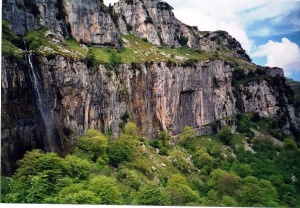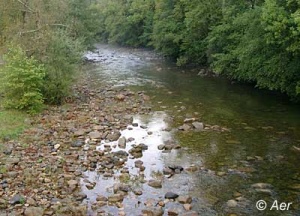Biodiversity conservation and recovery in the river basin of Asón
Biodiversity conservation and recovery in the river basin of Asón
Key features of the case study
Site description
The Ansón river source is located in the Collados del Asón Natural Park. It flows through habitats classified as of Community interest, including caves and rocks, peat bogs, beech and oak forests, Mediterranean holm-oak forests and gallery forests along its banks. These are the habitats of species of great interest such as Pyrenean musk rat, wolf, salmon and European bison. Downstream, where the waters from the river meet the sea, lie the Santoña salt marshes. This site is an important staging post on the migration route for hundreds of species of birds, which congregate there during the winter. Three sites representative of the valuable ecosystems along this river have been proposed for inclusion in the Natura 2000 network.
Measures selection
The aims of the project comprise not only the hydromorphological restoration of the river, but the conservation of the entire river basin. The project carries out diverse actions in three areas of the basin: at the head, in the middle, and at the estuary.
At the head of the basin,some of the developed actions were the treatment of caves for shelter conservation of bat colonies, the expansion and improvement of beech and oak forests, and the reintroduction of the Pyrenean Chamois.These measures benefit the ecosystems but also the local populations.
The measures at the river include environmental education information and awareness at the interpretation centre of the SCI.The improvement of instream habitat for salmonids, the recovery of otter, silvicultural treatments, hydrological study and monitoring of ecological flow are some of the actions developed.
The particular actions at the estuary were the recovery of the Mohedano dried marsh, removal of invasive plant species, revegetate riparian zones for protection purpose, and breeding of native mollusks.
Success criteria
Ecological response
Hydromorphological response
Monitoring before and after implementation of the project
Socio-economic aspects
Contact person within the organization
Fundación Naturaleza y Hombre[[1]]
- C/ 18 de Julio, 25
- 39610 El Astillero
- Spain
- Project Manager: Carlos Sánchez Martínez
- e-mail: fundacion@fundacionnaturalezayhombre.es
Extra background information
One of the main pressures is the surface water abstraction. In 1973 the Hydraulic Planning Service had the rights for extract 150 l/s over a period of 99 years from the Confederación Hidrográfica del Norte. The demographic evolution of the coast towns (even higher during the summer), the urbanisation and the increase of the industrial use of water made this concession obsolete. Subsequentley, the construction of bombs and the substitution of the existing pipes by ones of bigger capacity enabled the extraction of an amount of water much higher than allowed.
The reduction of flow at dry summer periods is reflected in the inexistence of flow. Also,this decrease would affect not only the Ason River, but to the Marshes themselves, where changes in the patterns of salinity (keys to the very existence of the marsh)during periods of severe drought alterations, may affect the biological communities.
Other threats to this site derived from human activities and over-use of the resources are: draining of the marshes, unauthorised shellfish farming, illegal fishing, poaching and the spread of exotic species. Misplanning and mismanagement of tourism, in turn, are having an adverse impact on conservation of some of these sites.
References
Web of the Life Project Biodiversity conservation and recovery in the river basin of Asón
[2]
Web of the NGO Naturaleza y Hombre. News related to the project
[[3]]
Related Measures
- Modify aquatic vegetation maintenance
- Develop riparian forest
- Adjust land use to develop riparian vegetation
- Revegetate riparian zones
- Restore wetlands

